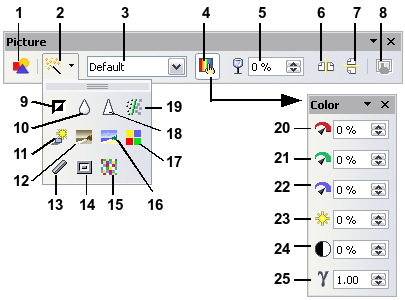Difference between revisions of "Documentation/OOo3 User Guides/Writer Guide/Modifying an image"
(New page: {{DISPLAYTITLE: Modifying an image - DRAFT}} {{Documentation/WG3GraphicsTOC |ShowPrevNext=block |PrevPage=Documentation/OOo3_User_Guides/Writer Guide/Adding images |NextPage=Documentation/...) |
m |
||
| Line 1: | Line 1: | ||
| − | {{DISPLAYTITLE: Modifying an image | + | {{DISPLAYTITLE: Modifying an image}} |
{{Documentation/WG3GraphicsTOC | {{Documentation/WG3GraphicsTOC | ||
|ShowPrevNext=block | |ShowPrevNext=block | ||
Revision as of 09:00, 13 January 2009
- Adding images to a document
- Modifying an image
- Cropping, resizing, rotating, and other settings
- Using Writer's drawing tools
- Positioning graphics within the text
- Arranging, anchoring, and aligning
- Wrapping text around graphics
- Examples of wrapping
- Adding captions to graphics
- Adding an image to the Gallery
- Graphic file types supported
When you insert a new image, you may need to modify it to make it more suitable for fitting into the document. The placement of the picture relative to the text is discussed in Positioning graphics within the text. This section describes the use of the Picture toolbar, resizing, and cropping, as well as a workaround to rotate a picture.
Using the picture toolbar
When you insert a suitable graphic image or select one already present in the document, the Picture toolbar appears. This toolbar can be either floating or docked. The figure below shows what the Picture toolbar looks like when it is floating. Two other toolbars can be opened from this one: the Graphic Filter toolbar, which can be torn off and placed elsewhere on the window, and the Color toolbar, which opens as a separate floating toolbar.
From these toolbars, you can apply small corrections to the graphic or obtain special effects.

1 From File
| 2 Filter
| 3 Graphics mode
| 4 Color
| 5 Transparency
| 6 Flip Horizontally
| 7 Flip Vertically
| 8 Graphics Properties
| 9 Invert
| 10 Smooth
| 11 Solarization
| 12 Aging
| 13 Charcoal Sketch
| 14 Relief
| 15 Mosaic
| 16 Posterize
| 17 Pop Art
| 18 Sharpen
| 19 Remove Noise
| 20 Red
| 21 Green
| 22 Blue
| 23 Brightness
| 24 Contrast
| 25 Gamma
(Above) Picture toolbar plus tear-off Graphic Filter toolbar and floating Color toolbar. Graphics mode (3) can be Default, Grayscale, Black/White, or Watermark.
Filters
Table 2 provides a short description of the available filters, however the best way to understand them is to see them in action. Feel free to experiment with the different filters and filters settings. remembering that you can undo all the changes by pressing Ctrl+Z or Alt+Backspace or by selecting Edit > Undo.
The figure below shows examples of some of the changes available on the Picture toolbar.
| Original Image | Flipped Vertically | Flipped Horizontally | Light 50% |
|---|---|---|---|

|

|

|

|
| Contrast 50% | Red 50% | Green 50% | Blue 50% |

|

|

|

|
Some graphic effects available from the Picture toolbar.
Table 1: Graphic filters and their effects
Color
Use this dialog box to modify the individual RGB color components of the image (red, green, blue) as well as the brightness, contrast, and gamma of the image. If the result is not satisfactory, you can press Control+Z to restore the default values.
Setting the object transparency
Modify the percentage value in the Transparency box ![]() on the Picture toolbar to make the image more transparent. This is particularly useful when creating a watermark or when wrapping the image in the background.
on the Picture toolbar to make the image more transparent. This is particularly useful when creating a watermark or when wrapping the image in the background.
Using the formatting toolbar and picture dialog
When an image is selected, you can customize some aspects of its appearance using the tools available on the Formatting toolbar as well as in the dialog that is shown by right-clicking on the image and selecting Picture. You can, for example, create a border around the image, selecting style and color; or you can (in the Borders page of the Picture dialog) add a shadow to the image.
| Content on this page is licensed under the Creative Common Attribution 3.0 license (CC-BY). |